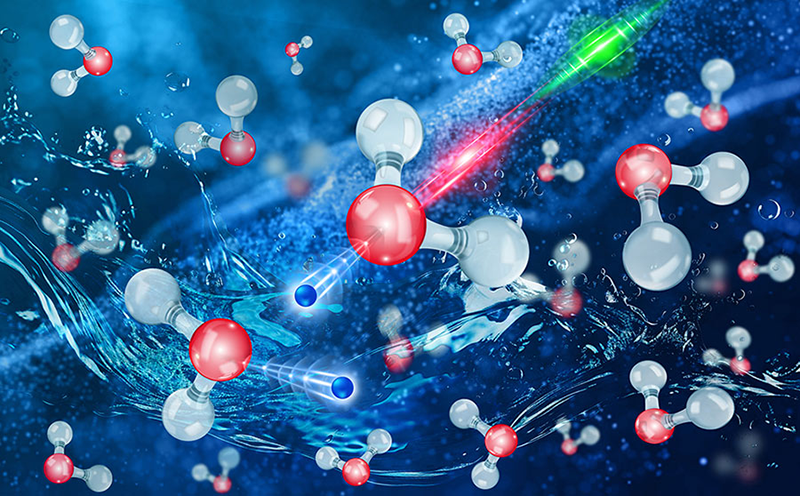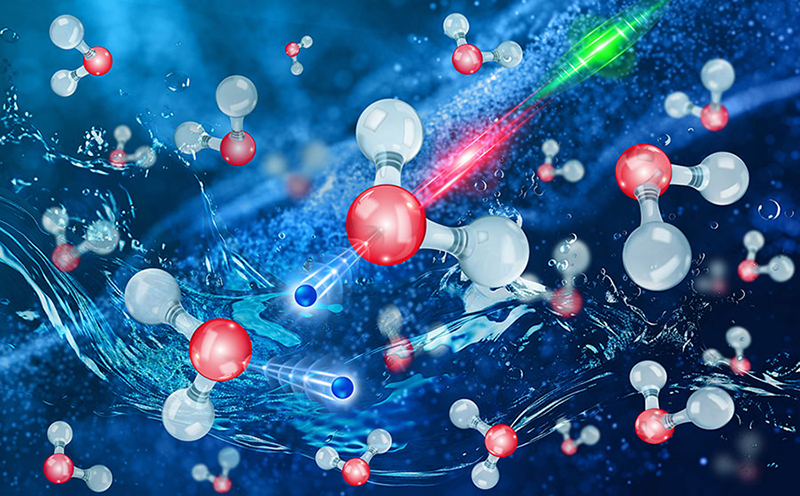Probing Liquid Water’s Structure with Attosecond X-Ray Pulses
Water is weird. Unlike other liquids its density doesn’t steadily increase as its temperature drops. Instead, water’s density peaks at 4 °C and then rapidly falls. To account for that behavior as well as for other weird water properties, physicists have proposed that within a given sample water molecules congregate in two coexisting “structural” motifs. Each motif is characterized by the number of hydrogen bonds among the water molecules and has a different density. Now a team of researchers from the US and Germany have performed an experiment that clarifies what the two-motif model can and can’t explain [1].
Liquid water owes its complex behavior to the propensity of its molecules to form hydrogen bonds. This bonding produces subtle shifts in the molecules’ energy levels that are absent in the gas phase. One such shift—a double-peaked feature in liquid water’s x-ray fluorescence spectrum that was discovered in 2008 [2, 3]—lent support to the two-motif model. However, alternative explanations for the data exist. One holds that the first peak arises from hydroxyl ions produced by the ionizing x rays, while the second arises from intact water molecules [4]. Another proposes that the double-peaked feature comes from the dynamics of the hydrogen-bonding process [5].
The 2008 experiments probed femtosecond timescales, allowing researchers to probe atomic motions. The new experiments probe attosecond timescales, short enough for the hydrogen and oxygen atoms to appear frozen in place.
For the experiments, the team used the Linac Coherent Light Source at the SLAC National Accelerator Laboratory in California. The researchers hit a liquid-water sample with a series of pulses at one-photon energy (the pump) and then a series of pulses at twice that energy (the probe). They chose a pump energy of 255–270 eV, an energy sufficient to ionize electrons in oxygen’s valence band. The energy of the ensuing 510–540 eV probe was then sufficient to promote core electrons to the positions of the ionized ones.
After passing through the liquid-water target, the probe traversed a spectral grating and then hit an x-ray camera. The spectrum registered by the camera resembled that measured in the 2008 experiments, except that the peak had only one bump, implying the water contained only one structural motif. That finding suggests the double peak observed in the femtosecond experiments has an alternative origin. The energy of the pump in those earlier experiments—as well as the new ones—was high enough to split a water molecule into a hydrogen ion and a hydroxyl ion, a process that plays out over a few femtoseconds. The new experiment was so fast that it probed the water molecules before any splitting could happen.
“Our experiment definitely rules out the argument that the double-peaked x-ray emission spectrum is evidence for two motifs in ambient liquid water,” says Linda Young of Argonne National Laboratory in Illinois, who was involved in the new study. Anders Nilsson investigates water’s structure at Stockholm University. He points out that the two peaks observed in the 2008 experiments could have arisen from the influence of the two motifs on water’s dissociation dynamics rather than from the motifs themselves. As an explanation for water’s weirdness, the two-motif model remains in play, he says.
–Charles Day
Charles Day is a Senior Editor for Physics Magazine.
References
- S. Li et al., “Attosecond-pump attosecond-probe x-ray spectroscopy of liquid water,” Science 383, 1118 (2024).
- O. Fuchs et al., “Isotope and temperature effects in liquid water probed by x-ray absorption and resonant x-ray emission spectroscopy,” Phys. Rev. Lett. 100, 027801 (2008).
- T. Tokushima et al., “High resolution x-ray emission spectroscopy of liquid water: The observation of two structural motifs,” Chem. Phys. Lett. 460, 387 (2008).
- V. W. D. Cruzeiro et al., “1b1 splitting in the x-ray emission spectrum of liquid water is dominated by ultrafast dissociation,” ChemRxiv preprint (2023).
- O. Takahashi et al., “Interpretation of the x-ray emission spectra of liquid water through temperature and isotope dependence,” Phys. Rev. Lett. 128, 086002 (2022).





